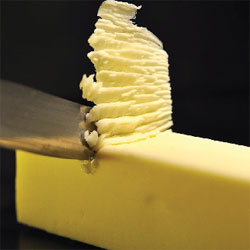Scratching Reaches the Breaking Point
It takes a lot more force to scratch a piece of steel than to scoop up butter with a knife, but the two actions may be more similar than previously thought. In the 20 May Physical Review Letters, a team demonstrates that scratching requires cutting through the material at a shallow depth, rather than simply deforming it by pressing down to make a groove. The researchers studied a variety of samples and scratching devices with controlled scratch tests, which researchers often use to characterize materials. The results offer improved understanding of the scratching process as well as a new way to measure the brittleness of materials, especially at small scales where current probing techniques are impractical.
Scratch tests have been used since antiquity to give the relative hardness of minerals. Quartz can scratch calcite, for example, so quartz is harder. Modern scratch tests measure the force required to make a scratch with a diamond stylus or other hard point. Geologists in the oil and gas industry use such information to characterize the rock at a drill site, and the automobile industry uses it to check the adhesion of coatings.
The microscopic details of scratching have been unclear, but the common assumption among materials researchers has been that the surface permanently deforms or yields, like a ball of silly putty after you press your finger into it. In this case, the force needed to create the scratch should increase proportionally with the cross-sectional area of the material being pushed out of the way. Imagine a snow plow that has to work harder when its plow is widened or the snow becomes deeper.
But this relation is not always strictly satisfied, according to Franz-Josef Ulm of the Massachusetts Institute of Technology and his colleagues. In recent work, they found that the force needed to scratch cement paste and sandstone was less dependent on the depth than would be expected by deformation of the surface [1]. A better fit to the data came from assuming that the scratching device was cutting chips off the surface, just like a knife does when it scoops out a slab of butter. This breaking, or fracture, would mostly depend on the width of the scratching device and only weakly depend on the depth.
To confirm the importance of fracture in scratching, the team performed a new round of experiments with materials spanning a range of hardness levels. On the soft end of the spectrum, they took paraffin wax and scratched the surface with rectangular “blades” of various widths between 2.5 and 25 millimeters. For a given width, the applied force increased with the square root of the penetration depth, which agreed with a model of fracture-dominated scratching devised by the team. This mathematical representation was based on the energy released by a crack propagating just ahead of the edge of the scratching device. The researchers found similar agreement with this model when they tested cement paste and limestone, but in this case the blades were titled slightly forward. As a final demonstration, they probed steel with a conical scratching device that is commonly used in scratch testing.
For each of the four experiments, the team showed how the scratch test data could be used to measure the fracture toughness, an important parameter in industry for characterizing a material’s brittleness. The fracture toughness is typically measured by introducing a small crack in a sample and observing the force needed to pull it open further and advance the crack. But if a scratch test also generates a crack–albeit a microscopic one–scratch tests could provide the same information in a simpler way. Ulm says scratch tests of different sizes could help engineers optimize concrete mixtures or help geologists better predict the outcome of hydraulic fracturing (or “fracking”) that aims to loosen up rocks surrounding oil and gas reserves.
Bhushan Karihaloo of Cardiff University in Wales thinks the work is significant and advances the understanding of fracture at micron and sub-micron scales. “The determination of fracture toughness at these scales is [currently] very difficult and inaccurate,” Karihaloo says. But Per-Lennart Larsson of the KTH Royal Institute of Technology in Stockholm is not convinced that fracture explains all scratching: “I have seen many, many scratch experiments where plastic deformation is the dominating feature, and not fracture at all.” Larsson thinks the new fracture model will be most useful in the study of brittle materials.
–Michael Schirber
Michael Schirber is a Corresponding Editor for Physics Magazine based in Lyon, France.
References
- A-T. Akono and F-J. Ulm, “Scratch Test Model for the Determination of Fracture Toughness,” Eng. Fract. Mech. 78, 334 (2011)
More Information
The Nondestructive Testing Resource Center provides information on material properties and testing procedures: hardness and fracture toughness





